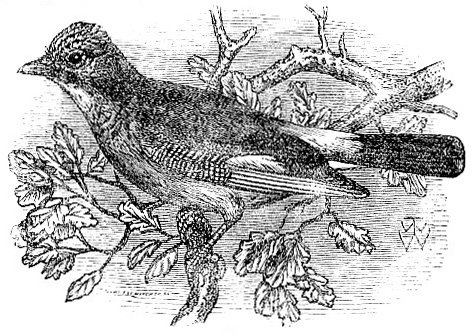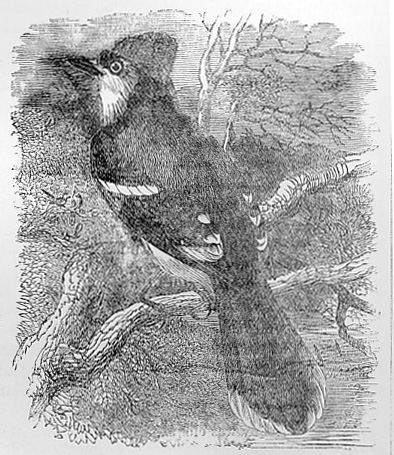1902 Encyclopedia > Jay
Jay (French, Geai), a well-known and very beautiful European bird, the Corvus glandarius of Linnaeus, the Garrulus alandrius of modern ornithologists. To this species are more or less closely allied numerous birds inhabiting the Palaearctic and Indian Regions, as well as the greater part of America, but not occurring in the Antilles, in the southern portion of the Neotropical Region, or in the Ethiopian or Australian. All these birds are commonly called Jays, and form agroup of the Crows or Corvidae, which may fairly be considered a Subfamily, Garrulinae. Indeed there are, or have been, systemstists who would elevate the Jays to the rank of a Family, Garrulidae -- a proceeding which seems unnecessary. Some of them have an unquestionable resemblance to the Pies, if the group now known by that name can be satisfactorily severed from the true Corvinae. In structure the Jays are not readily differentiated from the Pies; but in habit, so far as is known of them, they are much more arboreal, delighting in thick coverts, seldom appearing in the open, and seeking their food on or under trees. they seem also seem to walk or run when on the ground, but always to hop. The body-feathers are commonly loose and soft; and, gaily colored as are most of the species, in few of them has the plumage the metallic glossiness it generally presents in the Pies, while the proverbial beauty of the "Jay’s wing" is due to the vivid tints of blue-turquoise and cobalt, heightened by bars of jet-black, an indication of the same style of ornament being observable in the greater number of the other forms of the group, and in some predominating over nearly the whole surface. Of the many genera that have been proposed by ornithologists, perhaps about nine may be deemed sufficiently well established.

European Jay
The ordinary European Jay, Garrulus glandarius (fig. 1), has of late years suffered so much persecution in the British Islands as to have become in many districts a rare bird. In Ireland it seems now to be indigenous to the southern half of the island only; in England generally, it is far less numerous than formerly; and Mr. Lumsden (Scottish Naturalist, iii. pp. 230-240) has shewn that it Scotland its numbers have decreased with still greater rapidity. There is little doubt that it would have been exterminated by this time but for its stock being supplied in autumn by immigration, and for its shy and wary behavior, especially at the breeding-season, when it becomes almost wholly mute, and thereby often escapes detection. No truthful man, however much he may love the bird, gainsay the depredations on fruit and eggs that it at times commits; but the gardeners and gamekeepers of Britain fall into the usual error of persons imperfectly acquainted with the ways of nature, and, instead of taking a few simple steps to guard the charge from injury, or at most of publishing the individual birds from which the suffer, deliberately adopt methods of wholesale destructions-methods that in the case of this species are only too easy and too effectual -- by proffering temptation to trespass which it is not in Jay-nature to resist, and accordingly the bird runs great chance of total extirpation. Notwithstanding the war carried on against the Jay, its varied cries and active gesticulations shew it to be a sprightly bird, and at a distance that renders its beauty-spots invisible, it is yet rendered conspicuous by its cinnamon-colored body and pure white tail-coverts, which contrast with the deep black and rich chestnust that otherwise mark its plumage, and even the young at once assume a dress closely resembling that of the adult. The nest, generally concealed in a leafy tree or bush, is carefully built, with a lining formed of fine roots neatly interwoven. Herein from four to seven eggs, of a greenish-white closely freckled, so as to seem suffused with light olive, are laid in March or April, and the young on quitting it accompany their parents for some weeks.
Though the common Jay of Europe inhabits nearly the whole of this quarter of the globe south of 60° N. lat, its territory in the east of Russia is also occupied by G brancti, a kindred form, which replaces it on the other side of the ural, and ranges thence across Siberia to Japan; and again on the Lower Danube and thence to Constantinople the nearly-allied G. krynicki (which alone is found in southern Russia, Caucasia, and Asia Minor) shares its haunts with it. It also crosses the Mediterranean to Algeria and Morocco; but there, as in southern Spain, it is probably but a winter immigrant. The three forms just named have the widest range of any of the genus. Next to them come G. atricapillus, reaching from Syria to Beloochistan, G. japonicus, the ordinary Jay of southern Japan, and G. seninsis, the Chinese bird. Other forms have a much more limited area, as G. cervicalis, the local and resident Jay of Algeria, G. hyrcanus, found on the southern shores of the Caspian Sea, and G. taevanus confined to the island of Formosa. The most aberrant of the true Jay is G. lidthi, a very rare species, which seems to come from some part of Japan (vide Salvadori, Atti Accad. Torino vii. p. 474), though its exact locality is not known.
Leaving the true Jays of the genus Garrulus, it is expedient next to consider those of a group named, in 1831, Perisoreus by Bonaparte (Saggio, &c., Anim. Vertebrati, p 43) and Dysornithia by Swainson (F. B. Americana, ii. p. 495).

American Blue Jay
This group contains two species-one the Lanius infaustus of Linnaeus and the Siberian Jay of English writers, which ranges throughout the pine-forests of the north of Europe and Asia, and the second the Corvus Canadensis of the same author, or Canada Jay, occupying a similar station in America. The so-called Siberian Jay is one of the most entertaining birds in the world. Its versatile cries and actions, as seen and heard by those who penetrate the solitude of the northern forests it inhabits, can never be forgot ten by one who has had experience of them, any more than the pleasing sight of its rust colored tail, which an occasional gleam of sunshine will light up into a brilliancy quite unexpected by those who have only surveyed the bird’s otherwise gloomy appearance in the glass-case of a museum. It seems scarcely to know fear, obtruding itself on the notice of any passenger who invades its haunts, and, should he halt, making itself at once a denizen of his bivouac. In confinement it speedily becomes friendly, but suitable food for it is not easily found. Linnaeus seems to have been under a misapprehension when he applied to it the trivial epithet it bears; for by none of his countrymen is it deemed an unlucky bird, but rather the reverse. In fact, no one can listen to the cherry sound of its ordinary calls with any but a hopeful feeling. The Canada Jay, or "Whiskey-Jack" (the corruption probably of a Cree name), seems to be of a similar nature, but it presents a still more sombre coloration, its nestling plumage, indeed, being thoroughly Corvine in appearance and suggestive of its being a pristime form.
As though to make amends for the full plumage of the species last mentioned, North America offers some of the most brilliantly colored of the Subfamily, and the common Blue Jay of Canada and the Eastern States of the Union, Cyanurus cristatus (fig. 2), is one of the most conspicuous birds of the transatlantic woods. The account of its habits by Alexander Wilson is known to every student of ornithology, and Wilson’s followers have had little to do but supplement his history with unimportant details. In this bird and its many allied forms, coloration, though almost confined to various tints of blue, seems to reach its climax, but want of space forbids more particular notice of them, or of the members of the other genera Cyanocitta, Cyanocorrax, Zanthura, Psilorhinus, and more, which inhabit various parts of the Western continent. It remains, however, to mention the genus Cissa, including many beautiful forms belonging to the Indian region, and among them the C. speciosa and C. sinensis, so often represented in Oriental drawings, though doubts may be expressed whether these birds are not more nearly related to the Pies than to the Jays. ( A. N.)
The above article was written by Alfred Newton, M.A., F.R.S.; Professor of Zoology and Comparative Anatomy, University of Cambridge; late Chairman of Brit. Assoc. Migration of Birds Committee; President of the Cambridge Philosophical Society; author of Ornithology of Iceland and A Dictionary of Birds; edited The Ibis, 1865-70 and The Zoological Record, 1870-72.
|

